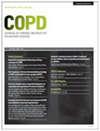Association of Body Mass Index and Abdominal Obesity with the Risk of Airflow Obstruction: National Health and Nutrition Examination Survey (NHANES) 2007–2012
IF 2.2
4区 医学
Q3 RESPIRATORY SYSTEM
COPD: Journal of Chronic Obstructive Pulmonary Disease
Pub Date : 2022-04-06
DOI:10.1080/15412555.2022.2032627
引用次数: 4
Abstract
Abstract This study aimed to explore the relationship between body mass index (BMI) and abdominal obesity and the risk of airflow obstruction, based on the data from the 2007–2012 National Health and Nutrition Survey (NHANES). Logistic regression was applied to assess the relationships between BMI or abdominal obesity and the risk of airflow obstruction by the fixed ratio method and the lower limit of normal (LLN) method. We further used the restricted cubic splines with 3 knots located at the 5th, 50th, and 95th percentiles of the distribution to evaluate the dose-response relationship. A total of 12,865 individuals aged 20–80 years old were included. In the fixed ratio method, underweight was positively correlated with the risk of airflow obstruction, and overweight and obesity were negatively correlated with the risk of airflow obstruction. In the LLN method, the results were consistent with the fixed ratio method. Abdominal obesity was positively associated with the risk of airflow obstruction only in the fixed ratio method (OR: 1.41, 95% CI: 1.04–1.90). There was an additive interaction between underweight and smoking on airflow obstruction in both methods. Abdominal obesity and smoking had additive interactions in the LLN method. Dose-response analysis indicated that there was a non-linear trend between BMI and the risk of airflow obstruction (P for nonlinearity < 0.01). Our study suggested that underweight and abdominal obesity were associated with the increased risk of airflow obstruction, and overweight and general obesity were associated with the decreased risk of airflow obstruction.体重指数和腹部肥胖与气流阻塞风险的关系:2007-2012年全国健康与营养调查(NHANES)
摘要本研究基于2007-2012年全国健康与营养调查(NHANES)的数据,旨在探讨体重指数(BMI)、腹部肥胖和气流阻塞风险之间的关系。采用Logistic回归方法,采用固定比值法和正常下限(LLN)法评估BMI或腹部肥胖与气流阻塞风险的关系。我们进一步使用3个结点位于分布的第5、第50和第95百分位的限制性三次样条来评估剂量-反应关系。共纳入年龄在20-80岁之间的12,865人。在固定比例法中,体重过轻与气流阻塞风险正相关,超重和肥胖与气流阻塞风险负相关。在LLN法中,结果与固定比率法一致。腹部肥胖仅在固定比例法中与气流阻塞风险呈正相关(OR: 1.41, 95% CI: 1.04-1.90)。在两种方法中,体重不足和吸烟对气流阻塞都有加性的相互作用。在LLN方法中,腹部肥胖和吸烟具有加性相互作用。剂量-反应分析显示BMI与气流阻塞风险呈非线性关系(P为非线性< 0.01)。我们的研究表明,体重过轻和腹部肥胖与气流阻塞风险增加有关,而超重和一般肥胖与气流阻塞风险降低有关。
本文章由计算机程序翻译,如有差异,请以英文原文为准。
求助全文
约1分钟内获得全文
求助全文
来源期刊

COPD: Journal of Chronic Obstructive Pulmonary Disease
RESPIRATORY SYSTEM-
CiteScore
4.40
自引率
0.00%
发文量
38
审稿时长
6-12 weeks
期刊介绍:
From pathophysiology and cell biology to pharmacology and psychosocial impact, COPD: Journal Of Chronic Obstructive Pulmonary Disease publishes a wide range of original research, reviews, case studies, and conference proceedings to promote advances in the pathophysiology, diagnosis, management, and control of lung and airway disease and inflammation - providing a unique forum for the discussion, design, and evaluation of more efficient and effective strategies in patient care.
 求助内容:
求助内容: 应助结果提醒方式:
应助结果提醒方式:


